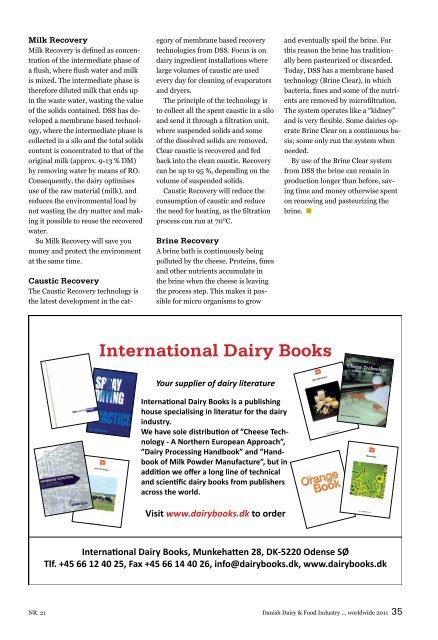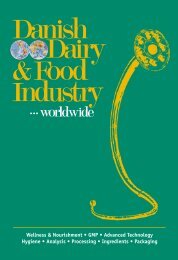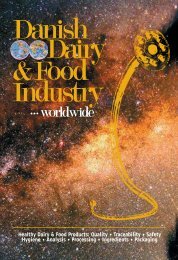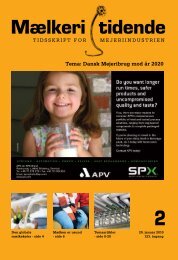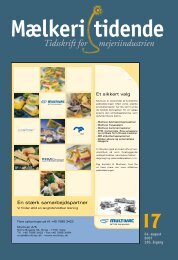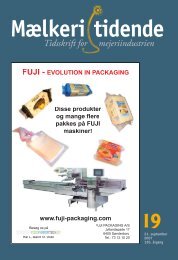Denmark - June 2011
Denmark - June 2011
Denmark - June 2011
You also want an ePaper? Increase the reach of your titles
YUMPU automatically turns print PDFs into web optimized ePapers that Google loves.
Milk Recovery<br />
Milk Recovery is defined as concentration<br />
of the intermediate phase of<br />
a flush, where flush water and milk<br />
is mixed. The intermediate phase is<br />
therefore diluted milk that ends up<br />
in the waste water, wasting the value<br />
of the solids contained. DSS has developed<br />
a membrane based technology,<br />
where the intermediate phase is<br />
collected in a silo and the total solids<br />
content is concentrated to that of the<br />
original milk (approx. 9-13 % DM)<br />
by removing water by means of RO.<br />
Consequently, the dairy optimises<br />
use of the raw material (milk), and<br />
reduces the environmental load by<br />
not wasting the dry matter and making<br />
it possible to reuse the recovered<br />
water.<br />
So Milk Recovery will save you<br />
money and protect the environment<br />
at the same time.<br />
Caustic Recovery<br />
The Caustic Recovery technology is<br />
the latest development in the cat-<br />
NR. 21<br />
egory of membrane based recovery<br />
technologies from DSS. Focus is on<br />
dairy ingredient installations where<br />
large volumes of caustic are used<br />
every day for cleaning of evaporators<br />
and dryers.<br />
The principle of the technology is<br />
to collect all the spent caustic in a silo<br />
and send it through a filtration unit,<br />
where suspended solids and some<br />
of the dissolved solids are removed.<br />
Clear caustic is recovered and fed<br />
back into the clean caustic. Recovery<br />
can be up to 95 %, depending on the<br />
volume of suspended solids.<br />
Caustic Recovery will reduce the<br />
consumption of caustic and reduce<br />
the need for heating, as the filtration<br />
process can run at 70°C.<br />
Brine Recovery<br />
A brine bath is continuously being<br />
polluted by the cheese. Proteins, fines<br />
and other nutrients accumulate in<br />
the brine when the cheese is leaving<br />
the process step. This makes it possible<br />
for micro organisms to grow<br />
International Dairy Books<br />
Your supplier of dairy literature<br />
International Dairy Books is a publishing<br />
house specialising in literatur for the dairy<br />
industry.<br />
We have sole distribution of ”Cheese Technology<br />
- A Northern European Approach”,<br />
”Dairy Processing Handbook” and ”Handbook<br />
of Milk Powder Manufacture”, but in<br />
addition we offer a long line of technical<br />
and scientific dairy books from publishers<br />
across the world.<br />
Visit www.dairybooks.dk to order<br />
and eventually spoil the brine. For<br />
this reason the brine has traditionally<br />
been pasteurized or discarded.<br />
Today, DSS has a membrane based<br />
technology (Brine Clear), in which<br />
bacteria, fines and some of the nutrients<br />
are removed by microfiltration.<br />
The system operates like a “kidney”<br />
and is very flexible. Some dairies operate<br />
Brine Clear on a continuous basis;<br />
some only run the system when<br />
needed.<br />
By use of the Brine Clear system<br />
from DSS the brine can remain in<br />
production longer than before, saving<br />
time and money otherwise spent<br />
on renewing and pasteurizing the<br />
brine. ■<br />
International Dairy Books, Munkehatten 28, DK-5220 Odense SØ<br />
Tlf. +45 66 12 40 25, Fax +45 66 14 40 26, info@dairybooks.dk, www.dairybooks.dk<br />
Danish Dairy & Food Industry … worldwide <strong>2011</strong> 35


